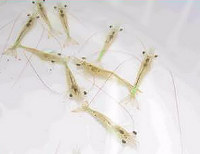Planning and operation
Larvae
 About
200.000 whiteleg shrimp post-larvae (stage PL 10-15) are purchased
in a frequency of 4 weeks from a certified (SPF) shrimp hatchery in
Florida (SIS / Shrimp Improvement Systems). The starter size of the
larvae is about 10mg. At arrival, the larval stages are kept in
special tanks with a salinity according to their origin (36psu). The
larvae are initially fed with newly hatched Artemia-nauplii,
co-feeding with Micro Diets, using a belt feeder, starts at once.
The salinity is decreased by 1psu per hour until the final salinity
in the production tanks is achieved (15 psu). After about ten days,
the larvae are transferred to the large production tanks.
About
200.000 whiteleg shrimp post-larvae (stage PL 10-15) are purchased
in a frequency of 4 weeks from a certified (SPF) shrimp hatchery in
Florida (SIS / Shrimp Improvement Systems). The starter size of the
larvae is about 10mg. At arrival, the larval stages are kept in
special tanks with a salinity according to their origin (36psu). The
larvae are initially fed with newly hatched Artemia-nauplii,
co-feeding with Micro Diets, using a belt feeder, starts at once.
The salinity is decreased by 1psu per hour until the final salinity
in the production tanks is achieved (15 psu). After about ten days,
the larvae are transferred to the large production tanks.
The farm opererators are planning to operate their own hatchery to become independant from larvae supplier and to get full control about the entire life cycle. The facilities to operate a hatchery are already installed.
Production
 The
production tanks are stocked with a density of 5-7 kg Whiteleg
shrimp biomass/sqm. The raceways are divided into 4 compartments,
each separated by a movable fence (see picture). The idea is to be
able to produce 3 generations in one raceway at a time. With
increasing size, the fences are pushed towards the one end of the
tanks, while replacing each time at the opposite a compartment with
early stages.
The
production tanks are stocked with a density of 5-7 kg Whiteleg
shrimp biomass/sqm. The raceways are divided into 4 compartments,
each separated by a movable fence (see picture). The idea is to be
able to produce 3 generations in one raceway at a time. With
increasing size, the fences are pushed towards the one end of the
tanks, while replacing each time at the opposite a compartment with
early stages.
Once a month, two raceways are stocked with 80.000 larvae. Both left tanks are stocked together, the next months both right tanks are stocked. The reason for this strategy is the water treatment facility; one pair of tanks has its own treatment system. A light cycle of 12:12 is applied with a slow dimming at the end and beginning of each daylight period. Compared to the production of fish, there is no grading procedure necessary. Almost no cannibalism was observed with the appropriate amount of food applied. Even in the post-molt phase, where the shrimp has to consolidate its cuticle and is in a quite vulnerable stage, there are no attacks observed.
The survival rate from larval stage to market size is about 60-70%. Feeding rate is from 16 – 1,5% related to the shrimp biomass; the food conversion rate (FCR) is about 2-3. The applied shrimp feed varies in protein (32-39%) and fat (8-10%) content, depending from the age of the cohort. The food is provided from a controlled eco-labelled production and the entire production process is free from any medication The shrimps are reared to a marketable size of 28-32g. The rearing period from larvae to market size is about 180 days. Each tank yields about 650 kg shrimps per complete rearing period. Prior to harvesting, the shrimps are deprived of food and kept some extra time in a compartment to allow to empty the guts. The farm aims to produce about 15 tons shrimps per year.
Marketing
The farm produces shrimp of a high, Sashimi-grade quality and exclusively market fresh shrimps which is unique in Germany. The product is advertised under the label "Cara Royal". Since the entire production process is controlled, any medication is abandoned and only certified food is applied, the quality is close to an organic labelling level. Since recirculation facilities cannot yet be certified as organic production, the farm aims at least to be certified by the Aquaculture Stewardship Council (ASC).
The farm has its own marketing strategy and sells their products
mainly to end-consumers and to restaurants. End-consumer can buy
shrimps at the farm gate or can order shrimps in the online shop of
the farm. The orders are individually caught, packed on ice and
delivered by express mailing to customers. Regional restaurants with
a more significant demand of fresh shrimps can ask for the delivery
service of the farm.

The farm has its own marketing strategy and sells their products mainly to end-consumers and to restaurants. End-consumer can buy shrimps at the farm gate or can order shrimps in the online shop of the farm. The orders are individually caught, packed on ice and delivered by express mailing to customers. Regional restaurants with a more significant demand of fresh shrimps can ask for the delivery service of the farm.